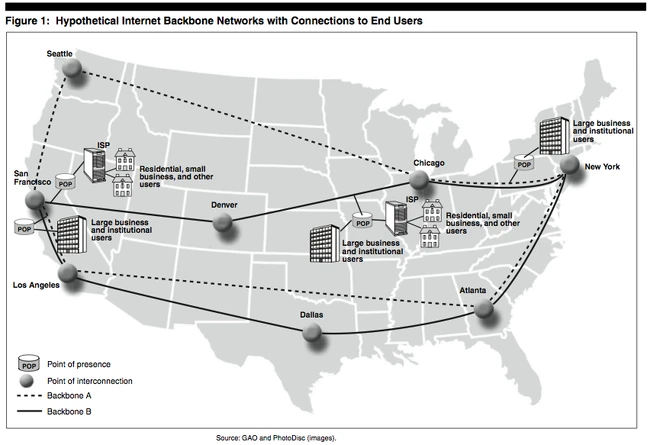Definitions[]
The backbone (also referred to as the Internet backbone)
| “ | [t]he main data routes between the large, strategically interconnected networks and core routers on the Internet. It is made up of multiple redundant networks owned and managed by numerous companies and covering many countries. . . . Backbone networks consist of hundreds of strands of fiber optic cable connecting major cities and countries, including submarine cables laid on the ocean floor.[1] | ” |
| “ | [is a] high-capacity communications channel that carries data accumulated from smaller branches of a computer or telecommunications network.[2] | ” |
| “ | provides a long-distance, high-capacity, high-speed transmission path for transporting massive quantities of data, much like the way a large multi-lane interstate highway allows large amounts of traffic quickly to travel long distances. Most backbone consists of fiber optic lines, either buried in the ground or laid under the sea. In addition, backbone can be provided using satellite systems and radio spectrum.[3] | ” |
Overview[]
The first Internet backbone was implemented in the United States by the National Science Foundation in 1986.
A backbone generally has greater data-carrying capacity, or "bandwidth," than the networks connected to it. The Internet backbone is the interconnection of high-speed networks, primarily government, commercial telecommunications and academic networks that route data for public Internet users.
The hierarchical structure of physical links, roughly speaking, runs from "backbone" networks to "regional" networks to "local" networks. The Internet backbone consists of many different networks. Usually, the term is used to describe large networks that interconnect with each other and may have individual ISPs as clients. For example, a local ISP may provide service for a single town, and connect to a regional provider which has several local ISPs as clients. This regional provider connects to one of the backbone networks, which provides nationwide or worldwide connections.
These backbone providers usually provide connection facilities in many cities for their clients, and they themselves connect with other backbone providers at Internet Exchange Points (IXPs), such as MAE-East in the eastern United States or FreeIX in France. The largest of these IXPs in terms of both throughput and connected peers is the Amsterdam Internet Exchange.
| “ | The interconnection arrangements between these providers are largely governed by private agreements. Voluntary interconnection has traditionally been part of the Internet model for network infrastructure. Moreover, most backbone markets are either relatively competitive or dominated by a single national operator that is already regulated. Regulators have generally not felt it necessary to impose special obligations for Internet backbone interconnection, except in merger cases.[4] | ” |
"Much of the terrestrial fiber optic backbone in the United States has been constructed along public rights of way created for railroad, telephone, and electric-utility owned companies. Providers have created additional backbone capacity in the form of undersea cables and satellite systems."[5]
References[]
- ↑ Digital Trade in the U.S. and Global Economies, Part 1, at xi.
- ↑ Bringing Health Care Online: The Role of Information Technologies, at 216.
- ↑ Deployment of Advanced Telecommunications Capability: Second Report, at 10.
- ↑ The Development and Diffusion of Digital Content, at 34.
- ↑ Deployment of Advanced Telecommunications Capability: Second Report, at 11.
See also[]
- The Digital Handshake: Connecting Internet Backbones
- E-government Backbone Network
- Internet backbone
- Internet backbone provider
- Telecommunications: Characteristics and Competitiveness of the Internet Backbone Market
- Very high-speed Backbone Network Service
| This page uses Creative Commons Licensed content from Wikipedia (view authors). | 
|
